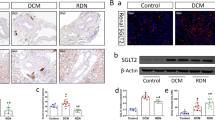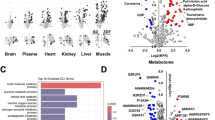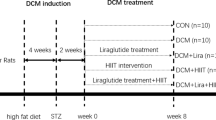Abstract
Aim:
Matrine is an alkaloid from Sophora alopecuroides L, which has shown a variety of pharmacological activities and potential therapeutic value in cardiovascular diseases. In this study we examined the protective effects of matrine against diabetic cardiomyopathy (DCM) in rats.
Methods:
Male SD rats were injected with streptozotocin (STZ) to induce DCM. One group of DCM rats was pretreated with matrine (200 mg·kg−1·d−1, po) for 10 consecutive days before STZ injection. Left ventricular function was evaluated using invasive hemodynamic examination, and myocardiac apoptosis was assessed. Primary rat myocytes were used for in vitro experiments. Intracellular ROS generation, MDA content and GPx activity were determined. Real-time PCR and Western blotting were performed to detect the expression of relevant mRNAs and proteins.
Results:
DCM rats exhibited abnormally elevated non-fasting blood glucose levels at 4 weeks after STZ injection, and LV function impairment at 16 weeks. The cardiac tissues of DCM rats showed markedly increased apoptosis, excessive ROS production, and activation of TLR-4/MyD-88/caspase-8/caspase-3 signaling. Pretreatment with matrine significantly decreased non-fasting blood glucose levels and improved LV function in DCM rats, which were associated with reducing apoptosis and ROS production, and suppressing TLR-4/MyD-88/caspase-8/caspase-3 signaling in cardiac tissues. Incubation in a high-glucose medium induced oxidative stress and activation of TLR-4/MyD-88 signaling in cultured myocytes in vitro, which were significantly attenuated by pretreatment with N-acetylcysteine.
Conclusion:
Excessive ROS production in DCM activates the TLR-4/MyD-88 signaling, resulting in cardiomyocyte apoptosis, whereas pretreatment with matrine improves cardiac function via suppressing ROS/TLR-4 signaling pathway.
Similar content being viewed by others
Log in or create a free account to read this content
Gain free access to this article, as well as selected content from this journal and more on nature.com
or
References
American Diabetes Association Editors. Diagnosis and classification of diabetes mellitus. Diabetes Care 2009; 32 Suppl 1: S62–7.
Cai L, Kang YJ . Cell death and diabetic cardiomyopathy. Cardiovasc Toxicol 2003; 3: 219–28.
Fang ZY, Prins JB, Marwick TH . Diabetic cardiomyopathy: evidence, mechanisms, and therapeutic implications. Endocr Rev 2004; 25: 543–67.
Giacco F, Brownlee M . Oxidative stress and diabetic complications. Circ Res 2010; 107: 1058–70.
Cai L, Kang YJ . Oxidative stress and diabetic cardiomyopathy: a brief review. Cardiovasc Toxicol 2001; 1: 181–93.
Khullar M, Al-Shudiefat AA, Ludke A, Binepal G, Singal PK . Oxidative stress: a key contributor to diabetic cardiomyopathy. Can J Physiol Pharmacol 2010; 88: 233–40.
Cai L, Wang Y, Zhou G, Chen T, Song Y, Li X, et al. Attenuation by metallothionein of early cardiac cell death via suppression of mitochondrial oxidative stress results in a prevention of diabetic cardiomyopathy. J Am Coll Cardiol 2006; 48: 1688–97.
Zhang F, Wang X, Tong L, Qiao H, Li X, You L, et al. Matrine attenuates endotoxin-induced acute liver injury after hepatic ischemia/reperfusion in rats. Surg Today 2011; 41: 1075–84.
Lao Y . Clinical study on effect of matrine injection to protect the liver function for patients with primary hepatic carcinoma after trans-artery chemo-embolization (TAE). Zhong Yao Cai 2005; 28: 637–8.
Lei ZL, Liu XJ, Ma JX, Zhu J . Effects of matrine on airway inflammation and early airway remodeling in asthmatic mice. Zhonghua Jie He He Hu Xi Za Zhi 2009; 32: 165–70.
Gao HY, Li GY, Lou MM, Li XY, Wei XY, Wang JH . Hepatoprotective effect of matrine salvianolic acid B salt on carbon tetrachloride-induced hepatic fibrosis. J Inflamm (Lond) 2012; 9: 16.
Li T, Wong VK, Yi XQ, Wong YF, Zhou H, Liu L . Matrine induces cell anergy in human Jurkat T cells through modulation of mitogen-activated protein kinases and nuclear factor of activated T-cells signaling with concomitant up-regulation of anergy-associated genes expression. Biol Pharm Bull 2010; 33: 40–6.
Zhang B, Liu ZY, Li YY, Luo Y, Liu ML, Dong HY, et al. Antiinflammatory effects of matrine in LPS-induced acute lung injury in mice. Eur J Pharm Sci 2011; 44: 573–9.
Li X, Zhou R, Zheng P, Yan L, Wu Y, Xiao X, et al. Cardioprotective effect of matrine on isoproterenol-induced cardiotoxicity in rats. J Pharm Pharmacol 2010; 62: 514–20.
Oyama J, Blais C Jr., Liu X, Pu M, Kobzik L, Kelly RA, et al. Reduced myocardial ischemia-reperfusion injury in toll-like receptor 4-deficient mice. Circulation 2004; 109: 784–9.
Yousif NG, Al-Amran FG . Novel Toll-like receptor-4 deficiency attenuates trastuzumab (herceptin) induced cardiac injury in mice. BMC Cardiovasc Disord 2011; 11: 62.
Chao W . Toll-like receptor signaling: a critical modulator of cell survival and ischemic injury in the heart. Am J Physiol Heart Circ Physiol 2009; 296: H1–12.
Riad A, Bien S, Gratz M, Escher F, Westermann D, Heimesaat MM, et al. Toll-like receptor-4 deficiency attenuates doxorubicin-induced cardiomyopathy in mice. Eur J Heart Fail 2008; 10: 233–43.
Zhang Y, Peng T, Zhu H, Zheng X, Zhang X, Jiang N, et al. Prevention of hyperglycemia-induced myocardial apoptosis by gene silencing of Toll-like receptor-4. J Transl Med 2010; 8: 133.
Zhao P, Wang J, He L, Ma H, Zhang X, Zhu X, et al. Deficiency in TLR4 signal transduction ameliorates cardiac injury and cardiomyocyte contractile dysfunction during ischemia. J Cell Mol Med 2009; 13: 1513–25.
Sarir H, Mortaz E, Karimi K, Kraneveld AD, Rahman I, Caldenhoven E, et al. Cigarette smoke regulates the expression of TLR4 and IL-8 production by human macrophages. J Inflamm (Lond) 2009; 6: 12.
Nakahira K, Kim HP, Geng XH, Nakao A, Wang X, Murase N, et al. Carbon monoxide differentially inhibits TLR signaling pathways by regulating ROS-induced trafficking of TLRs to lipid rafts. J Exp Med 2006; 203: 2377–89.
Matsuzawa A, Saegusa K, Noguchi T, Sadamitsu C, Nishitoh H, Nagai S, et al. ROS-dependent activation of the TRAF6-ASK1-p38 pathway is selectively required for TLR4-mediated innate immunity. Nat Immunol 2005; 6: 587–92.
Zhai C, Yu L, Zhu H, Tian M, Xiaogang Z, Bo W . Porcine CTLA4-Ig prolong islet xenografts in rats by downregulating the direct pathway of T-cell activation. Xenotransplantation 2011; 18: 40–5.
Labieniec-Watala M, Siewiera K, Jozwiak Z . Resorcylidene aminoguanidine (RAG) improves cardiac mitochondrial bioenergetics impaired by hyperglycaemia in a model of experimental diabetes. Int J Mol Sci 2011; 12: 8013–26.
Bocchi L, Savi M, Graiani G, Rossi S, Agnetti A, Stillitano F, et al. Growth factor-induced mobilization of cardiac progenitor cells reduces the risk of arrhythmias, in a rat model of chronic myocardial infarction. PLoS One 2011; 6: e17750.
Yu W, Wu J, Cai F, Xiang J, Zha W, Fan D, et al. Curcumin alleviates diabetic cardiomyopathy in experimental diabetic rats. PLoS One 2012; 7: e52013.
Kong SS, Liu JJ, Yu XJ, Lu Y, Zang WJ . Protection against ischemia-induced oxidative stress conferred by vagal stimulation in the rat heart: involvement of the AMPK-PKC pathway. Int J Mol Sci 2012; 13: 14311–25.
Xu J, Zhou X, Deng Q, Huang Q, Yang J, Huang F . Rapeseed oil fortified with micronutrients reduces atherosclerosis risk factors in rats fed a high-fat diet. Lipids Health Dis 2011; 10: 96.
Lv J, Jia R, Yang D, Zhu J, Ding G . Candesartan attenuates Angiotensin II-induced mesangial cell apoptosis via TLR4/MyD88 pathway. Biochem Biophys Res Commun 2009; 380: 81–6.
Boudina S, Abel ED . Diabetic cardiomyopathy revisited. Circulation 2007; 115: 3213–23.
Codinach Huix P, Freixa Pamias R . Diabetic cardiomyopathy: concept, heart function, and pathogenesis. An Med Interna 2002; 19: 313–20.
Aydemir-Koksoy A, Bilginoglu A, Sariahmetoglu M, Schulz R, Turan B . Antioxidant treatment protects diabetic rats from cardiac dysfunction by preserving contractile protein targets of oxidative stress. J Nutr Biochem 2010; 21: 827–33.
Cosson S, Kevorkian JP . Left ventricular diastolic dysfunction: an early sign of diabetic cardiomyopathy? Diabetes Metab 2003; 29: 455–66.
Frustaci A, Kajstura J, Chimenti C, Jakoniuk I, Leri A, Maseri A, et al. Myocardial cell death in human diabetes. Circ Res 2000; 87: 1123–32.
Baraka A, AbdelGawad H . Targeting apoptosis in the heart of streptozotocin-induced diabetic rats. J Cardiovasc Pharmacol Ther 2010; 15: 175–81.
Ho FM, Liu SH, Liau CS, Huang PJ, Lin-shiau SY . High glucose-induced apoptosis in human endothelial cells is mediated by sequential activations of c-Jun NH(2)-terminal kinase and caspase-3. Circulation 2000; 101: 2618–24.
Wang GW, Klein JB, Kang YJ . Metallothionein inhibits doxorubicin-induced mitochondrial cytochrome c release and caspase-3 activation in cardiomyocytes. J Pharmacol Exp Ther 2001; 298: 461–8.
Fiordaliso F, Bianchi R, Staszewsky L, Cuccovillo I, Doni M, Laragione T, et al. Antioxidant treatment attenuates hyperglycemia-induced cardiomyocyte death in rats. J Mol Cell Cardiol 2004; 37: 959–68.
Liu ZW, Zhu HT, Chen KL, Dong X, Wei J, Qiu C, et al. Protein kinase RNA-like endoplasmic reticulum kinase (PERK) signaling pathway plays a major role in reactive oxygen species (ROS)-mediated endoplasmic reticulum stress-induced apoptosis in diabetic cardiomyopathy. Cardiovasc Diabetol 2013; 12: 158.
Cai L, Li W, Wang G, Guo L, Jiang Y, Kang YJ . Hyperglycemia-induced apoptosis in mouse myocardium: mitochondrial cytochrome C-mediated caspase-3 activation pathway. Diabetes 2002; 51: 1938–48.
Johansen JS, Harris AK, Rychly DJ, Ergul A . Oxidative stress and the use of antioxidants in diabetes: linking basic science to clinical practice. Cardiovasc Diabetol 2005; 4: 5.
Watanabe K, Thandavarayan RA, Harima M, Sari FR, Gurusamy N, Veeraveedu PT, et al. Role of differential signaling pathways and oxidative stress in diabetic cardiomyopathy. Curr Cardiol Rev 2010; 6: 280–90.
Dasu MR, Devaraj S, Zhao L, Hwang DH, Jialal I . High glucose induces toll-like receptor expression in human monocytes: mechanism of activation. Diabetes 2008; 57: 3090–8.
Dasu MR, Devaraj S, Park S, Jialal I . Increased toll-like receptor (TLR) activation and TLR ligands in recently diagnosed type 2 diabetic subjects. Diabetes Care 2010; 33: 861–8.
Takata S, Sawa Y, Uchiyama T, Ishikawa H . Expression of toll-Like receptor 4 in glomerular endothelial cells under diabetic conditions. Acta Histochem Cytochem 2013; 46: 35–42.
Ladefoged M, Buschard K, Hansen AM . Increased expression of toll-like receptor 4 and inflammatory cytokines, interleukin-6 in particular, in islets from a mouse model of obesity and type 2 diabetes. APMIS 2013; 121: 531–8.
Riad A, Jager S, Sobirey M, Escher F, Yaulema-Riss A, Westermann D, et al. Toll-like receptor-4 modulates survival by induction of left ventricular remodeling after myocardial infarction in mice. J Immunol 2008; 180: 6954–61.
Frantz S, Kobzik L, Kim YD, Fukazawa R, Medzhitov R, Lee RT, et al. Toll4 (TLR4) expression in cardiac myocytes in normal and failing myocardium. J Clin Invest 1999; 104: 271–80.
Kawai T, Adachi O, Ogawa T, Takeda K, Akira S . Unresponsiveness of MyD88-deficient mice to endotoxin. Immunity 1999; 11: 115–22.
Ha T, Hua F, Li Y, Ma J, Gao X, Kelley J, et al. Blockade of MyD88 attenuates cardiac hypertrophy and decreases cardiac myocyte apoptosis in pressure overload-induced cardiac hypertrophy in vivo. Am J Physiol Heart Circ Physiol 2006; 290: H985–94.
Han KJ, Su X, Xu LG, Bin LH, Zhang J, Shu HB . Mechanisms of the TRIF-induced interferon-stimulated response element and NF-kappaB activation and apoptosis pathways. J Biol Chem 2004; 279: 15652–61.
Janssens S, Beyaert R . A universal role for MyD88 in TLR/IL-1R-mediated signaling. Trends Biochem Sci 2002; 27: 474–82.
Salaun B, Romero P, Lebecque S . Toll-like receptors' two-edged sword: when immunity meets apoptosis. Eur J Immunol 2007; 37: 3311–8.
Hengartner MO . The biochemistry of apoptosis. Nature 2000; 407: 770–6.
Huang D, Fang F, Xu F . Hyperoxia-induced up-regulation of Toll-like receptors expression in alveolar epithelial cells. Zhongguo Wei Zhong Bing Ji Jiu Yi Xue 2011; 23: 645–9.
Liu ZW, Zhu HT, Chen KL, Qiu C, Tang KF, Niu XL . Selenium attenuates high glucose-induced ROS/TLR-4 involved apoptosis of rat cardiomyocyte. Biol Trace Elem Res 2013; 156: 262–70.
Acknowledgements
We thank Ms Ning JING for her expert technical assistance.
Author information
Authors and Affiliations
Corresponding author
Rights and permissions
About this article
Cite this article
Liu, Zw., Wang, Jk., Qiu, C. et al. Matrine pretreatment improves cardiac function in rats with diabetic cardiomyopathy via suppressing ROS/TLR-4 signaling pathway. Acta Pharmacol Sin 36, 323–333 (2015). https://doi.org/10.1038/aps.2014.127
Received:
Accepted:
Published:
Issue date:
DOI: https://doi.org/10.1038/aps.2014.127
Keywords
This article is cited by
-
Exogenous H2S initiating Nrf2/GPx4/GSH pathway through promoting Syvn1-Keap1 interaction in diabetic hearts
Cell Death Discovery (2023)
-
Basic fibroblast growth factor alleviates metabolic abnormalities in the heart of streptozotocin-induced diabetic rats
International Journal of Diabetes in Developing Countries (2023)
-
Rhein alleviates advanced glycation end products (AGEs)-induced inflammatory injury of diabetic cardiomyopathy in vitro and in vivo models
Journal of Natural Medicines (2023)
-
Promising Therapeutic Treatments for Cardiac Fibrosis: Herbal Plants and Their Extracts
Cardiology and Therapy (2023)
-
Activation of the GPX4/TLR4 Signaling Pathway Participates in the Alleviation of Selenium Yeast on Deltamethrin-Provoked Cerebrum Injury in Quails
Molecular Neurobiology (2022)



